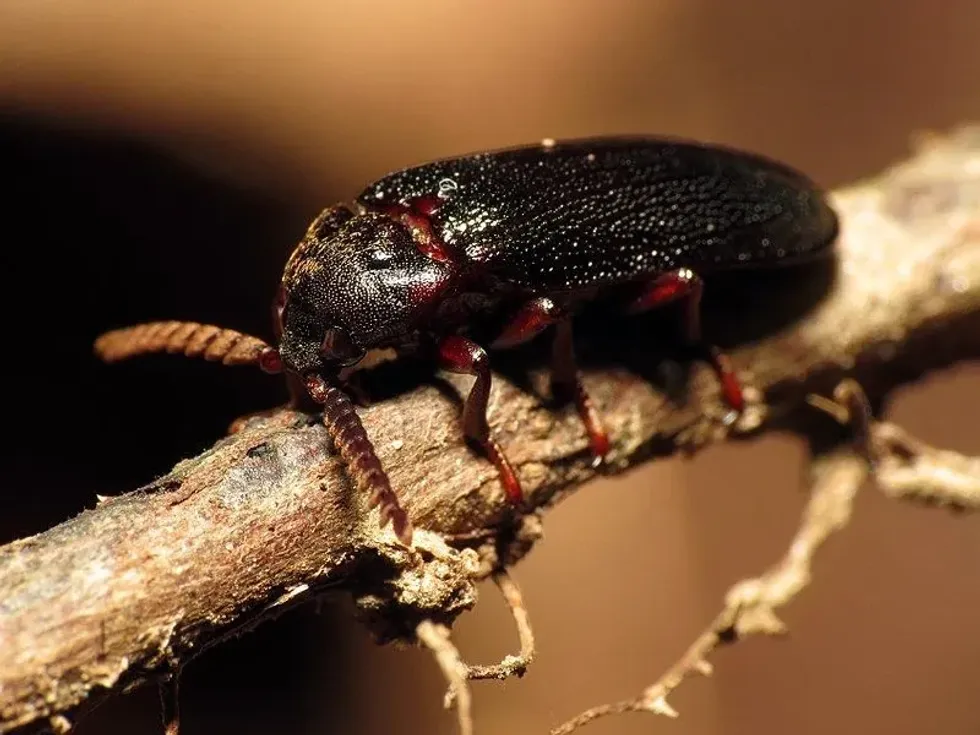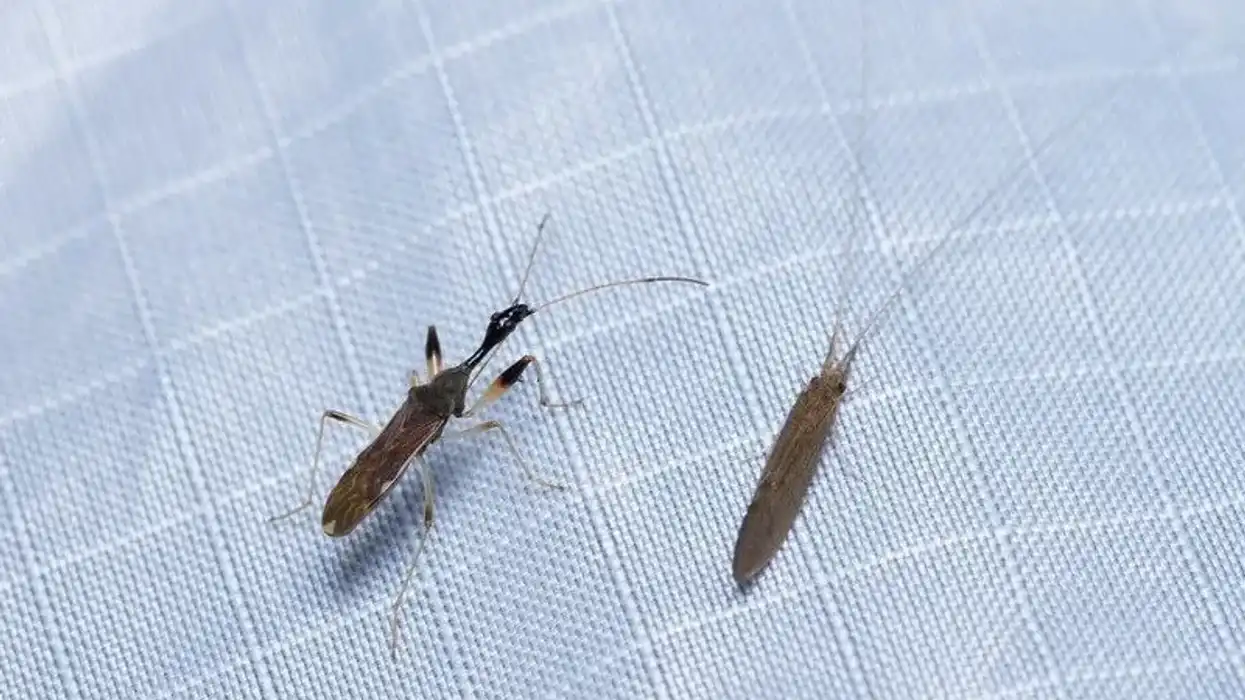The cedar beetle, scientifically known as Sandalus niger, belongs to the family Rhipiceridae. It is also known as the cicada parasite beetle as it is known to have a parasitic association with the cicada larvae.
These can be spotted in large numbers crawling or flying in or around trees. These are mostly found in North America and can be spotted in or around branches, tops, trunks, and inhabits or attack weakened, dead, or fallen trees.
The eggs are laid in bark crevices or cracks. This larva burrows through the soil looking for cicada nymphs, the larva then seized onto this cicada nymph and tends to feed on its nymph.
These beetles feed on twigs. The mature larvae pupate in some years and come out as adults.
The description of this beetle includes a dark brown body while many members of this family are also known to be reddish-brown in color. The head is known to be pointed downwards.
The dorsal part is flattened. The antennae are known to have fan-like tips.
Both the males and females fly. Some consider this beetle a pest, but commonly it is not considered a pest and this beetle is known to be the least aggressive; although, this beetle still possesses the capability to damage trees.
It is quite interesting to know about this beetle and if you are interested, read about weevil beetle facts and Africanized bees facts too.
Cedar Beetle Interesting Facts
What type of animal is a cedar beetle?
Cedar beetles are beetles.
What class of animal does a cedar beetle belong to?
It belongs to the class of Insecta.
How many cedar beetles are there in the world?
There has been no specific number of these beetles estimated or recorded.
Where does a cedar beetle live?
These beetles are mostly found in North America.
What is a cedar beetle's habitat?
It is believed that these beetles are spotted around branches, tops, trunks and inhabits or attack weakened, dead, or fallen trees. It is believed that the male beetles fly at certain temperatures that range from 15-30 degrees Celcius. As anything under this leads to immobilization among males.
Who does cedar beetle live with?
Beetles tend to live alone.
How long does a cedar beetle live?
The exact lifespan is unknown.
How do they reproduce?
Not much information is available regarding the breeding or reproduction of these beetles, but just like any other beetle, this beetles' life cycle stages include eggs, larva, pupa, and adult. The eggs are laid in bark crevices or cracks by females.
These larvae burrow through soil looking for cicada nymphs, the larva then seized onto this cicada nymph tend to feed on its nymph. The mature larvae pupate and come out as adults in some years when the periodical cicadas appear.
What is their conservation status?
The conservation status of this species is unknown.
Cedar Beetle Fun Facts
What does the cedar beetle look like?
The cedar beetle is known to be chunkily built and is dark brown in color. The head of this cedar beetle is known to be pointed downwards. The dorsal part of this beetle is flattened. The abdomen is known to be hidden by the wing coverings which are of orangish color.
Males tend to have short comb-like antennae. The antennae are known to have fan-like tips. The larvae that hatch is known to be slender and active. Larvae are known to be grubs that are legless.
How cute are they?
These beetles are not considered cute.
How do they communicate?
Beetles are known to communicate through chemical cues like pheromones and also through different sounds and sights.
How big is a cedar beetle?
This species of beetles are known to be very small beetles and are quite small as compared to other species of beetles like the rhinoceros beetle and are around 0.5-1 in (0.012-0.025 m) long.
How fast can a cedar beetle run?
These beetles are known to be the fastest when they are on two hind legs. Certain species of beetles are known to be the fastest running insects like the (Australian Tiger Beetle), which is known to run 5.6 mph (9 kph).
How much does a cedar beetle weigh?
The weight of this beetle is not recorded.
What are the male and female names of the species?
There are no specific names for males and females of the species.
What would you call a baby cedar beetle?
The baby of this species is referred to as larva or larvae.
What do they eat?
These cedar beetles are known to feed on twigs.
Are they poisonous?
This cedar beetle is not considered poisonous.
Would they make a good pet?
Not much information is available regarding these beetles as pets but some other species like diving beetles, stag beetles, and horned rhinoceros beetles are commonly kept as pets.
Did you know...
It is believed that the female of these beetles lay their eggs on trees in order to make it appear like predators are attacking the tree, similar to the Asian longhorned beetle.
This beetle is known to be active during the day.
This beetle is known to be mistaken for a firefly when flying out in flight.
While commonly this beetle is not considered to be a pest, some believe that this beetle keeps the population of cicadas in control.
The difference between this beetle and the cedar bark beetle can be seen in the appearance as the latter is known to be reddish-brown in color and its hosts include rocky mountains and junipers.
Another member namely, the Japanese cedar longhorn beetle is known to bore trees of the cypress family and the females are known to have reddish-brown wings.
Another member of this family, feather horned cedar beetle is considered to be a small family and is found in Australia.
How do I get rid of cedar beetles?
An easy and homemade way of getting rid of these beetles includes a dish soap and water solution. You just have to add water in a spray bottle and around four tablespoons of dish soap. This solution can be sprayed on the beetles.
Other ways include insecticides and vacuuming the beetles.
What bugs eat cedar wood beetles?
Chewing bugs are known to eat cedar wood beetles.
Here at Kidadl, we have carefully created lots of interesting family-friendly animal facts for everyone to discover! For more relatable content, check out these paper wasp facts and mayfly facts pages.
You can even occupy yourself at home by coloring in one of our free printable cedar beetle beetle pages.









